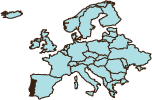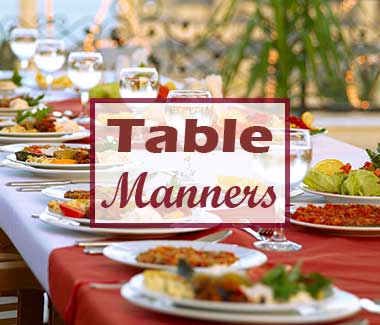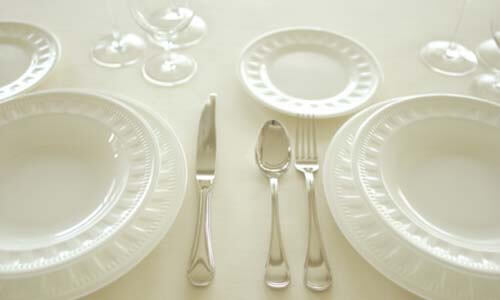Portuguese Dining Etiquette
Dining etiquette for toasts. Portuguese toasting etiquette follows universal toasting rules - that is, guests should lift their goblets only after the host has initiated a toast to the person being honored. The most common toast is salud (to your health).
table manners
Dining etiquette for beginning to eat. Do not begin eating until the host says, "Bom appetito!".
Dining etiquette for utensils. Portuguese do not switch knives and forks. The knife remains in the right hand, and the fork remains in the left. When the meal is finished, the knife and fork are laid parallel to each other across the right side of the plate. If you put both utensils down on the plate for any real length of time it is a sign to the waitstaff that you are finished, and your plate may be taken away from you. Alternately, if you lay your cutlery down on either side of the plate, it means that you haven't finished.
Dining etiquette for the place setting. The fork and spoon above your plate are for dessert. There may be several additional pieces of cutlery; if you're unsure of which utensil to use, always start from the outside and work your way in, course by course. There will be separate glasses provided at your setting for water and white and red wine (after-dinner drink glasses come out after dinner).
Dining etiquette for eating bread. Bread is usually served without butter (therefore, there usually will not be a butter knife, nor will there be a bread dish: bread is placed on the rim of your main plate or on the table by your plate).
Dining etiquette for your hands. When not holding utensils, your hands should be visible.
Dining etiquette for napkin use. Keep your napkin visible, and when you are finished with the meal, fold it first before putting it down on the table.
Dining etiquette for passing food. Pass all dishes to your left at the table.
Dining etiquette for eating salad. Never cut the lettuce in a salad. Fold it with your knife and fork into a little bundle that can be picked up with your fork.
Dining etiquette for seating. The most honored position is at the head of the table, with the primary guest seated immediately to the right of the host (women to the right of the host, and men to the right of the hostess). If there is a hosting couple, one will be seated at each end of the table.
Dining etiquette for restaurants. You may be required to share a table. Waitstaff may be summoned by making eye contact.
Dining etiquette for talking business. Depending upon how well developed your relationship is with your Portuguese colleagues, meals are generally not the time to make business decisions. Take your cue from your Portuguese associates.
Dining etiquette for the home. Allow the more senior members of your party to enter rooms ahead of you. Wait until the host indicates your seat.
Dining etiquette for paying the bill. Usually the one who does the inviting pays the bill. Sometimes other circumstances determine the payee (such as rank).
Dining etiquette for tipping. A 15 percent tip is usually sufficient in restaurants. Restaurants sometimes have the 15 percent tip already included on the bill.




